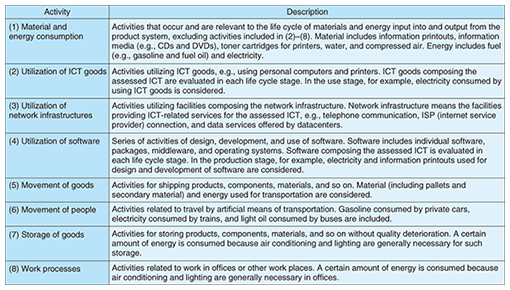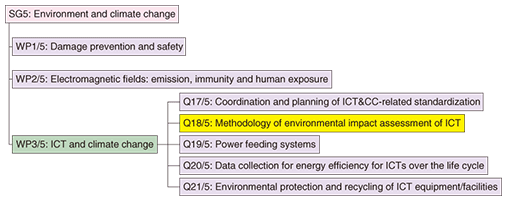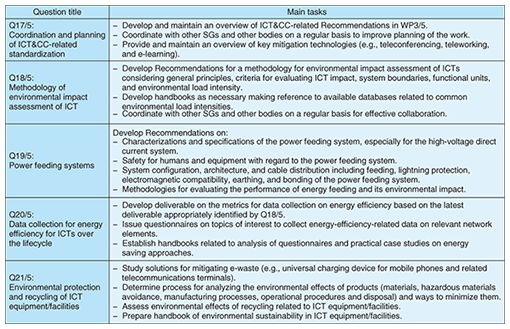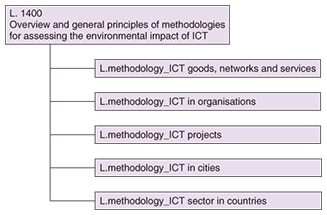 |
|||||||||||||
|
|
|||||||||||||
|
Feature Articles: Environment and Energy Technologies Toward a Green Society Vol. 9, No. 2, pp. 57–62, Feb. 2011. https://doi.org/10.53829/ntr201102fa9 Quantifying Environmental Load Reduction Effect of Utilizing ICTAbstractThis article describes our methodology for assessing the environmental impact of information and communications technology (ICT) and reports on international standardization activities regarding ICT and the environment.
1. ICT and its environmental impactThe recent rapid spread of information and communications technology (ICT), such as the Internet, broadband access, and mobile communications, has accelerated the paradigm shift from an industrial society to an information society. ICT has a large influence on the environmental, economic, and social aspects of our lives. However, the impact of ICT on the global environment is becoming larger, such as the increase in energy consumption due to the spread of the always-connected Internet. The environmental impact of ICT has both negative and positive aspects, as shown in Fig. 1.
Negative aspects result from the environmental load caused by ICT. They include energy consumption due to the electricity used by ICT devices and networks, the use of natural resources for producing ICT devices and constructing facilities, and the generation of waste from the disposal of ICT devices and dismantling of facilities. Positive aspects are associated with the reduction in environmental load achieved by ICT services. Some examples of the positive aspects are: - Dematerialization, which refers to the replacement of physical production and distribution of music, video, books, and software, etc. by the delivery of digital information over the network; - Reduction of movement through the use of videoconferencing; - Reduction of transportation through the use of intelligent transport systems; - More efficient industry through supply chain management systems; - More efficient lifestyles through the use of information appliances; - Enhancement of environmental awareness and environmental education; and - Reduction of the environmental load through the use of environmental sensors and environmental monitoring. To construct a sustainable society from an environmental viewpoint, it is important to minimize the negative aspects of ICT and maximize the positive ones. To this end, both the positive and negative environmental aspects of ICT must be quantitatively evaluated. 2. Evaluation of ICT environmental impactThe “Guideline for Information and Communication Technology (ICT) Eco-Efficiency Evaluation” [1] (hereafter called the Guidelines) was published by the Japan Forum on Eco-Efficiency in March 2006. It is a uniform domestic standard for quantitatively evaluating the environmental impact associated with the implementation of ICT. NTT has played an active role in establishing the Guidelines for technology for evaluating the environmental impact of networks and ICT services. The Guidelines state that the ICT environmental load should be assessed using life cycle assessment (LCA) conforming to the ISO 14040 series and JISQ 14040 series. The LCA technique quantitatively evaluates the environmental impact at each stage in the life cycle of goods or services, from the acquisition of raw materials to production, use, and disposal. For each life-cycle stage, the Guidelines classify the activities to be evaluated, i.e., the activities that have an impact through the use of an ICT service, into eight categories as shown in Table 1. The Guidelines state that the following items should be taken into account in an evaluation of the environmental load of the network infrastructure (Activity (3) in Table 1): - Units of evaluation regarding the type of telecommunication system (circuit switching and packet communication); - Evaluation period of network infrastructure consisting of many communication facilities having different lifetimes; and - Allocation procedure for each type of facility (customer premises, access network, and core network).
The Guidelines also state the classification of software and the method of allocation when evaluating the environmental load of software (Activity (4) in Table 1). Moreover, they discuss a framework for performing a comparative evaluation of ICT services or a comparative evaluation between an ICT service and a traditional means on the basis of the environmental load evaluation. Here, traditional means refers to an existing means or service that does not use ICT, such as a face-to-face meeting involving a business trip, which can be evaluated in comparison with videoconferencing. In a comparative evaluation, we first determine the ICT service for comparison (target ICT service) and then set up another ICT service or traditional means as a baseline service. We evaluate the environmental load reduction effect of the ICT service by evaluating the difference between the environmental loads of the target ICT service and the baseline service. This section has given a brief outline of the ICT environmental impact evaluation stated in the Guidelines. For more details, see reference [2]. 3. Application to environmental managementThe NTT Group is promoting activities for better communicating the environmental contributions of ICT services to its customers by using the environmental impact evaluation method stated in the Guidelines. Examples of activities are the development of the “Environmental Impact Assessment System for ICT Services” [3], which is a tool for quantitatively evaluating the environmental load reduction effect of ICT services from an LCA standpoint, and of the “NTT Group Solution Environmental Label System” [4], which is a means of identifying NTT Group’s ICT solutions with notably low environmental impacts as eco-friendly. These activities promote the quantification of the environmental load reduction effect achieved by utilizing ICT. 4. International standardization activitiesThe environmental impact of ICT on climate change has drawn attention not only domestically but also globally. While the Guidelines state the domestic uniform methodology, evaluation methods have not been standardized internationally. The problems in establishing an internationally agreed methodology include securing fairness, adequacy, and transparency; being available for comparison between countries or regions considering the national or regional differences; and obtaining understanding from other sectors. These problems have led to a strong need to discuss international standardization for ICT and the environment. Under these circumstances, the Focus Group on ICTs and Climate Change (FG-ICT&CC) was established in the International Telecommunication Union, Telecommunication Standardization Sector (ITU-T) as a result of discussions in the Telecommunication Standardization Advisory Group (TSAG) meeting of ITU-T held in Geneva in July 2008 [5]. FG-ICT&CC engaged in vigorous discussion on issues related to standardization of an internationally agreed common methodology for measuring the reduction in CO2 emissions achieved by ICT. The FG-ICT&CC Deliverables were completed in March 2009, and the contents of the Guidelines were included in the final report of Deliverable 3 “Methodology”. The results of FG-ICT&CC Deliverables were reported at the TSAG meeting in April 2009, and the reorganization of Study Group 5 (SG5) on the environment and climate change was approved in the meeting. In response to this approval, the establishment of Working Party 3 (WP3/5) on ICT and climate change was approved in the SG5 meeting in May 2009, as shown in Fig. 2.
WP3/5 is composed of five questions (Qs), as shown in Table 2. Discussion in WP3/5 is becoming more active, as represented by the approval of the Recommendation on a universal power adapter for mobile devices in Q21/5. Moreover, Q18/5 is developing Recommendations for an ICT environmental impact assessment methodology (Fig. 3).
Recommendation L.1400 “Overview and general principles of methodologies for assessing the environmental impact of ICT” presents general principles for how to assess the environmental impact of ICT and outlines the different methodologies that are being developed. It states that the series of methodology Recommendations focuses on both energy consumption and greenhouse gas (GHG) emissions as assessment targets. L.1400 received consent as the first Recommendation on methodology in October 2010. The following five different methodologies are being developed as draft Recommendations. (1) Recommendation L.methodology_ICT goods, networks and services: This Recommendation aims to provide a methodology for evaluating the environmental impact of ICT goods, networks, and services objectively and transparently. It is scheduled to be approved by 2011. Japan is proposing the contents of the Guidelines as an LCA-based methodological framework and as a framework on comparative evaluation, which are under discussion in this Recommendation’s activities. (2) Recommendation L.methodology_ICT in organisations: This recommendation aims to provide a methodology for assessing the energy consumption and GHG emissions of ICT within organizations over a certain period of time, e.g., one year. It also aims to provide a methodology for assessing the energy consumption and GHG emissions of ICT organizations. This Recommendation is also scheduled to be approved by 2011. (3) Recommendation L.methodology_ICT projects: An ICT project is defined as either (i) a GHG project using mainly ICT goods, networks, and services aiming at GHG emissions reductions and enhancing GHG removal or enhancements or (ii) a project using mainly ICT goods, networks, and services aiming at energy consumption savings and energy efficiency improvements. (4) Recommendation L.methodology_ICT in cities: This recommendation aims to provide a GHG emissions reporting method that accounts for the positive and negative impacts of ICT in cities. This work item was established in October 2010. (5) Recommendation L.methodology_ICT in countries: This recommendation aims to provide a GHG emissions reporting method that accounts for the positive and negative impacts of ICT in countries or groups of countries. 5. Further studyWe will continue to work on establishing an internationally standardized assessment methodology that is objective and transparent, and we will promote activities quantifying the environmental load reduction effect achieved by ICT services provided by NTT Group. References
|
|||||||||||||
















